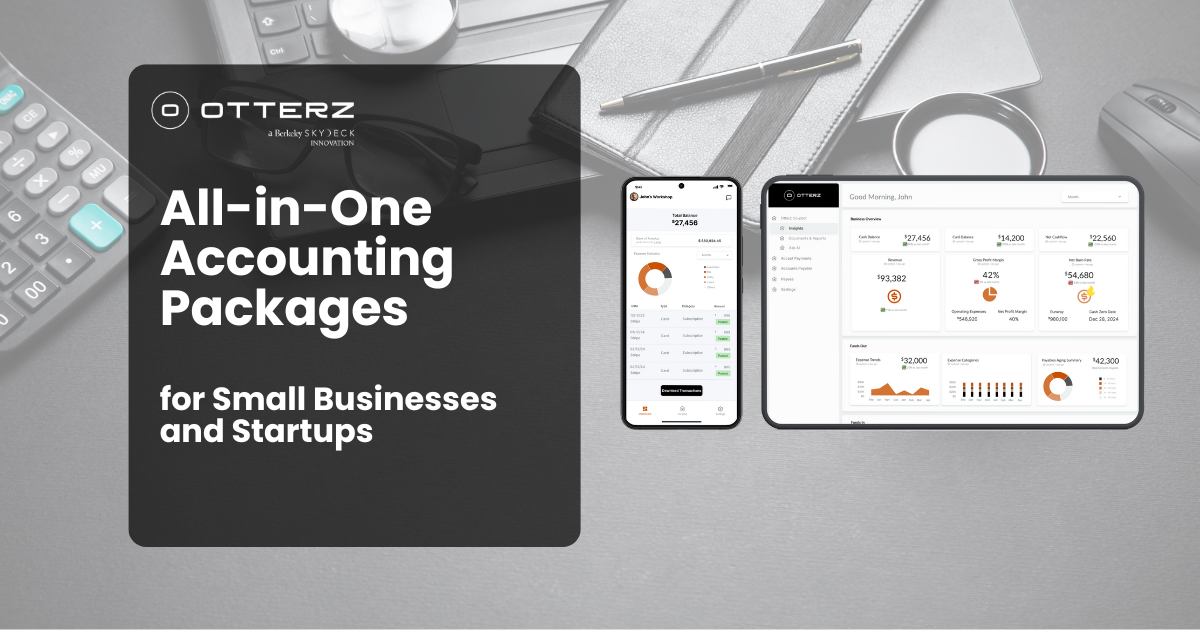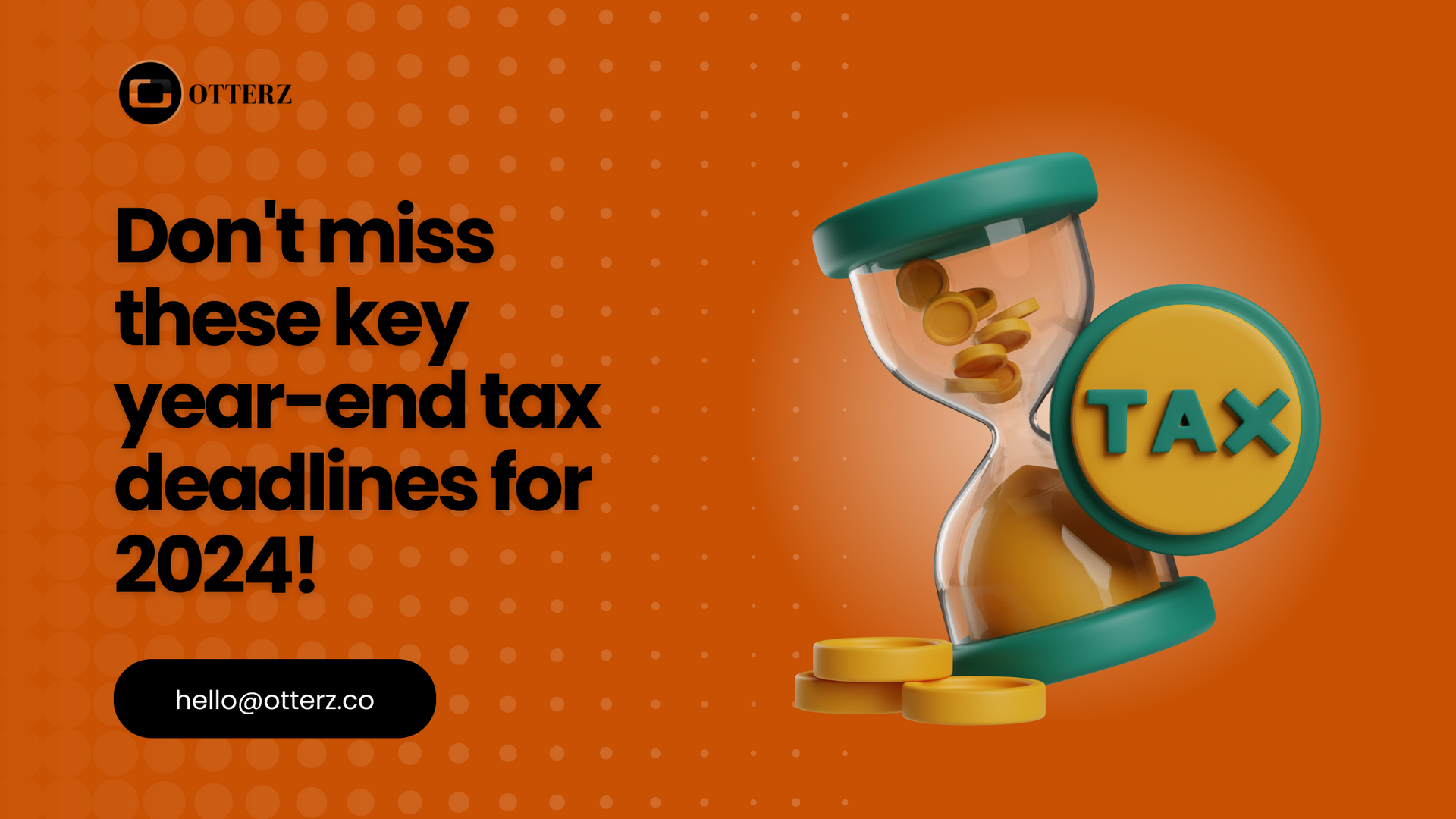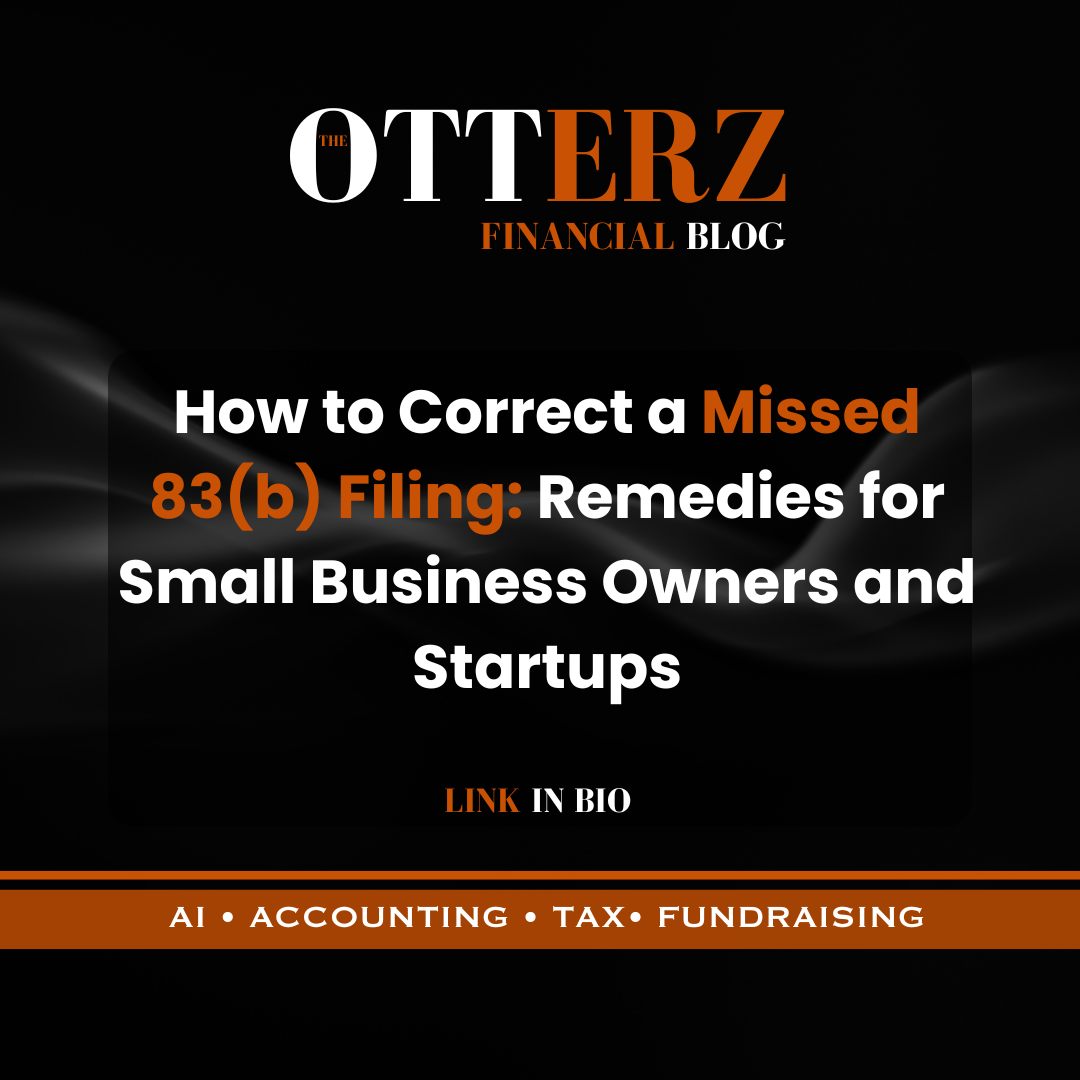Understanding the Research & Development (R&D) Tax Credit
"A man's accomplishments in life are the cumulative effect of his attention to detail."
John Foster Dulles
In this Article:
- Introduction to the R&D Tax Credit
- What is the R&D Tax Credit?
- Who Can Benefit from the R&D Tax Credit?
- Qualifying Activities for the R&D Tax Credit
- Benefits of the R&D Tax Credit
- How to Claim the R&D Tax Credit
- Determine Eligibility
- Identify Qualifying Expenses
- Calculate the Credit
- Document the Research Activities
- File the Appropriate Forms
- Maintain Records for Future Reference
- Consult with a Tax Professional
- Conclusion
- How Otterz can help with the R&D Tax Credit?
1. Introduction to the R&D Tax Credit
In today's competitive business environment, innovation is key to staying ahead. The U.S. government supports this innovation through the Research and Development (R&D) Tax Credit. This incentive is designed to encourage companies of all sizes—particularly small and medium-sized enterprises—to invest in and perform research and development activities. This blog post will cover what the R&D Tax Credit is, who can benefit from it, and how businesses can claim it.
2. What is the
R&D Tax Credit?
The Research & Development (R&D) Tax Credit, formally known as the Credit for Increasing Research Activities under Internal Revenue Code (IRC) Section 41, is a valuable financial incentive designed to encourage innovation and technical advancement among U.S. businesses. Established in 1981 and made permanent by Congress in 2015, the credit aims to spur economic growth by reducing the tax burden on companies investing in new technologies and processes.
The objective of the Credit
The primary goal of the R&D Tax Credit is to incentivize businesses to invest in research and development within the United States. By offsetting some of the costs associated with innovative research activities, the credit helps businesses increase their investment in R&D efforts without a proportional increase in their tax liabilities.
Eligibility Criteria
Eligibility for the R&D Tax Credit is broad, encompassing a range of industries and activities. It is not restricted to companies with dedicated R&D departments or those working in technology sectors. Instead, any business that engages in activities aimed at developing new, improved, or technologically advanced products, processes, software, or formulas may qualify. This inclusivity ensures that businesses across various sectors, from agriculture to software and engineering, can benefit from the credit.
Financial Benefits
The R&D Tax Credit can significantly reduce a company's federal and potentially state tax liabilities. The credit is calculated based on a percentage of qualified research expenditures (QREs), which include wages, supplies, and certain contract research expenses related to eligible research activities. For many companies, this credit provides a dollar-for-dollar reduction in their tax bill, enhancing their ability to reinvest in further innovation and development.
Impact on U.S. Economy
The broader impact of the R&D Tax Credit extends to enhancing the global competitiveness of the U.S. economy. By reducing the cost barriers to R&D investment, the credit facilitates higher levels of research activity, leading to technological advancements, job creation, and economic growth. This strategic focus on R&D not only supports individual businesses but also bolsters the technological leadership of the United States on the world stage.
3.
Who Can Benefit from the R&D Tax Credit?
The R&D Tax Credit is designed to benefit a wide range of industries and companies engaged in various forms of research and development activities. Its broad eligibility criteria make it accessible not only to large corporations with dedicated R&D departments but also to small and medium-sized enterprises that are involved in less formal research activities.
Industry Scope
The credit covers a diverse array of sectors. Here are some examples:
- Technology: Companies developing new software applications, hardware products, or IT tools.
- Manufacturing: Businesses engaged in designing new manufacturing processes, improving product efficiency, or developing new materials.
- Pharmaceuticals: Firms involved in drug discovery, testing, and development of new medical treatments.
- Agriculture: Enterprises working on new agricultural techniques, hybrid plant species, or improved crop yields.
- Food Science: Companies experimenting with new food processing methods, preservation techniques, or flavor enhancements.
- Aerospace: Organizations focused on advancements in aircraft design, systems engineering, or new propulsion technologies.
Size and Type of Business
The R&D Tax Credit is not limited to any specific size or type of business. Here are the various business types that can benefit:
- Startups: Even if they are not yet profitable, startups can claim the credit against payroll taxes, helping them offset some of the initial costs of their R&D activities.
- Small to Medium Enterprises (SMEs): SMEs often benefit the most, as the credit can significantly reduce their taxable income, thereby improving cash flow and allowing for reinvestment in additional R&D.
- Large Corporations:
These entities can utilize the credit to decrease their annual tax liabilities, thus supporting ongoing innovation and maintaining competitive advantage.
Eligibility Beyond Traditional R&D
It's a common misconception that the R&D Tax Credit is only for 'white coat' scientific research. However, businesses engaged in less traditional forms of R&D, such as developing new business models, enhancing software interfaces, or improving operational methods, can also qualify. What matters is not the industry or the novelty of the product itself but the process of experimentation and the pursuit of technological advancement.
Collaboration and Contracted Research
Companies that outsource their research activities to third parties may also qualify for the credit. However, specific rules determine how expenses related to contracted research are treated, and only 65% of payments made to contractors qualify for the credit. Collaboration between businesses and academic institutions can also fall under eligible activities, provided the research meets the IRS criteria.
4.
Qualifying Activities for the R&D Tax Credit
The R&D Tax Credit applies to a wide range of activities that contribute to research and development within various industries. To qualify for the credit, the activities must meet specific criteria defined by the IRS. This section details what constitutes qualifying activities and how businesses can determine if their research efforts are eligible.
Four-Part Test
To qualify for the credit, a company must demonstrate that its project (or business component) meets all the criteria for qualified research. This is determined through a four-part test. The components include:
- Section 174 Test: Eligible R&D expenses must be the type that can be treated as research or experimental expenditures under Section 174. This means the costs must be incurred in connection with a company’s trade or business and must represent expenses in the experimental or laboratory sense. These expenditures are intended to discover information that would eliminate uncertainty regarding the development or improvement of a product. Uncertainty exists if the information available does not establish the capability, method, or appropriate design of the product. The success, failure, sale, or use of the product is irrelevant to determining eligibility under Section 174.
- Technological Information Test: The R&D activity must fundamentally rely on principles of physical or biological sciences, engineering, or computer science to qualify.
- Business Component Test: The business must intend to apply the information discovered through R&D activities to improve an existing business component or develop a new one. A business component can be any product, process, technique, invention, or formula that is intended for sale, lease, license, or use in the taxpayer’s business. The research must be tied to a relevant business component.
- Process of Experimentation Test:
To pass this test, a company must show that substantially all of the research activities (at least 80%) are elements of a process of experimentation. This process evaluates one or more alternatives to achieve a result where the capability of achieving that result is uncertain at the beginning of the project.
Examples of Qualifying Activities
To better understand what might qualify, here are specific examples across various industries:
- Developing new software algorithms or improving existing ones to enhance performance or functionality.
- Engineering a new product or modifying an existing product to be faster, cheaper, more robust, or more environmentally friendly.
- Conducting environmental testing on new materials to determine if they are suitable for commercial use.
- Creating prototypes or models to test new concepts or validate product designs.
- Improving or developing new manufacturing processes that increase yield, reduce waste, or enhance safety.
Documentation and Substantiation
Proper documentation is crucial for claiming the R&D Tax Credit. Companies should keep detailed records that outline the nature of each experiment, the uncertainties involved, the experimentation process, and the qualified expenses incurred. Documentation can include project lists, design documents, testing results, financial records, and employee activity logs. This substantiation is essential if the IRS requests evidence supporting the claim.
Common Misconceptions
It's important to dispel some common misconceptions about qualifying activities:
- Activity doesn’t need to be successful: Research activities do not need to lead to a successful outcome to qualify. What matters is the process of experimentation and attempting to solve technological uncertainties.
- Routine product development can qualify: Even routine product development efforts may qualify if they involve some form of technological innovation or significant improvement.
5. Benefits of the R&D Tax Credit
The Research and Development (R&D) Tax Credit offers several significant benefits that help businesses reduce their tax liabilities and enhance their overall financial posture. This support not only impacts the individual companies that take advantage of the credit but also stimulates broader economic growth by encouraging a culture of continuous innovation. Here are the primary benefits of the R&D Tax Credit:
Reduction in Tax Liability
The most direct benefit of the R&D Tax Credit is its ability to reduce a company's tax liability. The credit is a dollar-for-dollar reduction against taxes owed or paid. For example, if a company spends $100,000 on qualifying R&D activities and is eligible for a 20% credit, it can reduce its tax bill by $20,000 directly. This reduction can significantly decrease the effective cost of research and development.
Increase in Cash Flow
By lowering tax liabilities, the R&D Tax Credit effectively increases a company's cash flow. This additional liquidity is crucial for businesses, especially small and medium-sized enterprises, allowing them to reinvest in their operations, hire new staff, expand their research capabilities, or reduce debt. For startups and companies that are not yet profitable, claiming the credit against payroll taxes can provide vital operational cash during critical growth phases.
Encourages Investment in Innovation
The financial relief provided by the R&D Tax Credit encourages businesses to invest in new and ongoing research projects. Knowing that a portion of the investment will be offset by tax savings, companies might be more inclined to undertake bold, innovative projects that they would otherwise deem too risky or expensive.
Competitive Advantage
Companies that claim the R&D Tax Credit can maintain or enhance their competitive advantage in several ways. By investing in innovation, businesses can develop superior products, improve efficiencies, and enter new markets. Furthermore, the savings from the credit can fund additional strategic initiatives that further differentiate the company from its competitors.
Encourages Investment in Innovation
The financial relief provided by the R&D Tax Credit encourages businesses to invest in new and ongoing research projects. Knowing that a portion of the investment will be offset by tax savings, companies might be more inclined to undertake bold, innovative projects that they would otherwise deem too risky or expensive.
Carryforward and Carryback Opportunities
If a company cannot use the entire credit amount in the current year because its tax liability is lower than the credit, the IRS allows the unused portion to be carried back one year and forward up to 20 years. This provision ensures that businesses can still benefit from the credit even in years when their tax liability is minimal, providing flexibility and long-term planning opportunities.
Enhanced Reputation
Engaging in research and development can also enhance a company's reputation. Being known for innovation can attract customers, partners, investors, and talent. Additionally, utilizing a government incentive like the R&D Tax Credit can position a company as an industry leader committed to advancing technology and contributing to economic progress.
6.
How to Claim the R&D Tax Credit
Claiming the R&D Tax Credit involves several key steps to ensure compliance and maximize the potential benefit. Understanding the process can help companies navigate the complexities of the tax code and accurately claim the credit. Here’s a detailed look at how to go about this:
1. Determine Eligibility
The first step in claiming the R&D Tax Credit is to determine whether your business and its activities qualify under the IRS definitions. This involves reviewing the nature of your projects to see if they meet the four-part test for qualifying activities: technological in nature, permitted purpose, elimination of uncertainty, and process of experimentation.
2. Identify Qualifying Expenses
Once you have established that your projects qualify, the next step is to identify and document all associated expenses. Qualifying expenses can include:
- Wages: Salaries paid to employees directly involved in, supervising, or supporting the R&D activities.
- Supplies: Materials and supplies used or consumed during the R&D process.
- Contract Research:
Payments made to third parties for conducting qualifying research on behalf of your company. Note that only 65% of these expenses typically qualify.
3. Calculate the Credit
The calculation of the R&D Tax Credit can be complex. Generally, the credit is calculated as a percentage of qualifying research expenditures over a base amount, which is determined based on a percentage of average gross receipts from prior years. The IRS offers two methods for calculation:
- Regular Credit Method: Generally 20% of the qualifying expenses over the base amount.
- Alternative Simplified Credit (ASC):
14% of the qualifying expenses that exceed 50% of the average qualifying expenses for the prior three tax years.
4. Document the Research Activities
Thorough documentation is critical to support your claim. This documentation should detail the research activities and demonstrate how they meet the IRS criteria for qualifying R&D activities. Include records like project lists, budget allocations, project notes and journals, prototypes, trial results, and payroll records.
5. File the Appropriate Forms
To officially claim the credit, you must fill out and attach Form 6765, Credit for Increasing Research Activities, to your company’s tax return. This form requires detailed information about the qualifying expenses and the credit calculation.
6. Maintain Records for Future Reference
After filing, it is important to maintain all records pertaining to the R&D Tax Credit claim. The IRS can audit tax returns up to three years after filing, and in some cases longer, so keeping detailed documentation is crucial.
7. Consult with a Tax Professional
Given the complexities involved in claiming the R&D Tax Credit, consulting with a tax professional who specializes in this area can be highly beneficial. A qualified expert can provide guidance throughout the process, help maximize the credit amount, and ensure compliance with IRS regulations.
Otterz offers specialized
R&D Tax Credit assistance as part of our Annual
All-in-One Accounting Package.
7. Conclusion
The Research and Development (R&D) Tax Credit is a pivotal tool for fostering innovation across a diverse array of industries in the United States. By financially rewarding companies that undertake research and development, the credit not only aids individual businesses in their growth and technological advancements but also contributes to the broader economic dynamism by encouraging investments in new technologies and processes.
Vital for Business Growth
In a competitive global market, continual innovation is key to staying ahead. The R&D Tax Credit effectively lowers the financial risk associated with innovation. Businesses can invest more boldly in research knowing that a portion of their expenses will be offset by tax savings. This safety net is especially critical for small and medium-sized enterprises and startups that might otherwise hesitate to allocate substantial funds to untested ideas and technologies.
Boosts U.S. Economy
Beyond individual businesses, the R&D Tax Credit plays a crucial role in maintaining the technological leadership of the United States on the global stage. By incentivizing research and development, the U.S. ensures its industries continue to push the boundaries of technology and science, contributing to job creation, higher productivity, and economic resilience.
Encourages a Culture of Innovation
The R&D Tax Credit also helps in building a culture of innovation within the U.S. economy. Companies are more likely to foster a creative environment when they know there is a tangible financial benefit to exploring new ideas. This culture not only leads to technological advancements but also attracts top talent who are eager to work in dynamic and forward-thinking environments.
Actively Engage with the Credit
Given the complexities involved in claiming the R&D Tax Credit, consulting with a tax professional who specializes in this area can be highly beneficial. A qualified expert can provide guidance throughout the process, help maximize the credit amount, and ensure compliance with IRS regulations. Otterz offers specialized R&D Tax Credit assistance as part of our Annual All-in-One Accounting Package.

How Otterz can help with your R&D Tax Credits?
It is advisable for businesses to continuously review their R&D strategies and expenditures with the help of qualified tax professionals. These experts can provide valuable guidance on how to maximize benefits, ensure compliance with the changing tax laws, and effectively document R&D activities to withstand IRS scrutiny.
At
Otterz, we recognize the complexity and potential of the
R&D Tax Credit.
That's why we offer specialized
R&D Tax Credit assistance
as part of our Annual
All-in-One Accounting Package. Our goal is to empower your business to leverage this tax incentive efficiently while you focus on driving innovation and growth. Partner with us to navigate the intricacies of R&D claims and secure your rightful benefits under this critical tax provision.
Sources:
Internal Revenue Service - Instructions for Form 6765 (Rev. January 2024). Available at: https://www.irs.gov/pub/irs-pdf/i6765.pdf (Accessed: 22 May 2024).
Internal Revenue Service - Research credit. Available at: https://www.irs.gov/businesses/research-credit (Accessed: 22 May 2024).
Internal Revenue Service - Audit techniques guide: Credit for increasing research activities (i.e., research tax credit) IRC § 41 - qualified research activities. Available at: https://www.irs.gov/businesses/audit-techniques-guide-credit-for-increasing-research-activities-i-e-research-tax-credit-irc-41-qualified-research-activities (Accessed: 22 May 2024).
Bloomberg Tax - R&D tax credit and deducting R&D expenditures. Available at: https://pro.bloombergtax.com/brief/rd-tax-credit-and-deducting-rd-expenditures/ (Accessed: 22 May 2024).
Tax Foundation - R&D tax credit: Federal research and development tax treatment. Available at:
https://taxfoundation.org/research/all/federal/research-and-development-tax/#_ftn21 (Accessed: 22 May 2024).
About the Authors:

Ektaa Shah
CPA & Taxation Expert
Ektaa is a Certified Public Accountant with a Master’s in Taxation, driven by a wealth of expertise and a commitment to excellence. Demonstrating dedication to academic and professional achievement, Ektaa has gained valuable experience across diverse industries, including professional service firms, life sciences and consumer goods. Serving as a tax specialist on audits and serving as a tax advisor for small to medium sized-businesses, she developed a deep understanding of complex tax issues. Beyond her professional endeavors, Ektaa is actively involved in community service and leadership. She proudly serves as the Treasurer on the Board of Directors for the non-profit organization Womanspace, demonstrating her commitment to giving back and empowering others.

Daniel Ionescu
Marketing Expert
Daniel is an Experienced Marketing Expert deeply passionate about financial technologies, startups, and small business growth. He is dedicated to empowering startups and small businesses through insightful content and innovative tools designed to enhance financial management and operational efficiency. Daniel is committed to delivering valuable, tech-driven solutions to entrepreneurs and business owners.
Found this valuable? Share it with your friends and colleagues!








